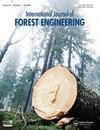The effect of tree and harvester size on productivity and harvester investment decisions
IF 2.1
3区 农林科学
Q2 FORESTRY
引用次数: 2
Abstract
ABSTRACT Long-term machine-derived data sets comprising 140,000 trees were collected from four harvesters of equal age and similar working conditions, into two machine size classes, viz. two Ponsse Bears and two smaller Ponsse Beavers. Productivity functions for each size class were modelled using a nonlinear mixed effects approach. Based on these functions, unit costs and their sensitivity to utilization rates and cost of capital were assessed. Results showed that despite considerably higher capital costs (32%) on the Bear, a 50% higher mean productivity resulted in a unit cost only 17% higher than the Beaver in a disadvantageous scenario (high interest rates and low utilisation), and a 6% lower unit cost than the Beaver in an advantageous scenario (low interest and high utilisation), within the range of tree sizes observed. Between these extremes, only marginal differences in unit costs were observed. This demonstrates that the difference in ownership and operating costs between larger and smaller harvesters is largely negated by the difference in productivity rates. These results can provide useful insight into timber harvester investment decisions. Harvesters from two adjacent size classes can be used interchangeably at the same unit cost within a wide range of tree sizes despite productivity differences. It should be noted that increased repair costs and an eventual reduction in expected economic lifetime on a smaller harvester, or the negative effects of using a larger harvester in smaller trees, e.g. thinning operations, were not taken into account in this work.树木和收割机尺寸对生产力和收割机投资决策的影响
摘要从四台年龄相同、工作条件相似的收割机上收集了包括140000棵树的长期机器衍生数据集,分为两个机器大小的类别,即两只庞塞熊和两只较小的庞塞海狸。使用非线性混合效应方法对每个规模类别的生产力函数进行建模。根据这些函数,评估了单位成本及其对利用率和资本成本的敏感性。结果表明,尽管Bear的资本成本(32%)高得多,但在不利情况下(高利率和低利用率),平均生产率高出50%,单位成本仅比Beaver高17%,在有利情况下(低利率和高利用率)的单位成本比Beaver低6%,在观察到的树木大小范围内。在这些极端之间,只观察到单位成本的边际差异。这表明,大型和小型收割机在所有权和运营成本方面的差异在很大程度上被生产率的差异所抵消。这些结果可以为木材收割机的投资决策提供有用的见解。来自两个相邻尺寸类别的收割机可以在大范围的树木尺寸内以相同的单位成本互换使用,尽管生产力存在差异。需要注意的是,这项工作没有考虑到维修成本的增加和小型收割机预期经济寿命的最终缩短,或者在小型树木上使用大型收割机的负面影响,例如疏伐作业。
本文章由计算机程序翻译,如有差异,请以英文原文为准。
求助全文
约1分钟内获得全文
求助全文

 求助内容:
求助内容: 应助结果提醒方式:
应助结果提醒方式:


